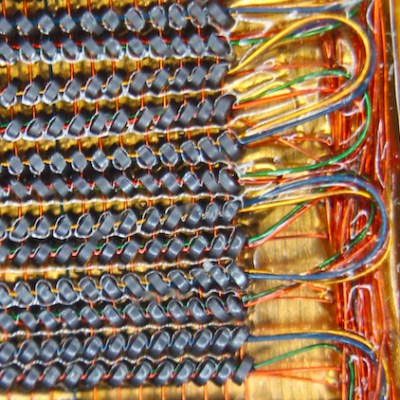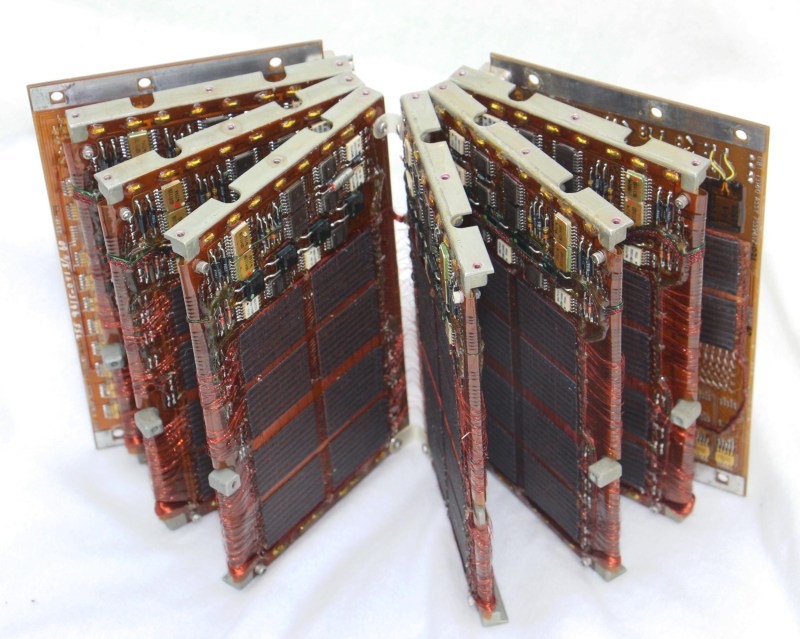Longtime followers of [Ken Shirriff’s] work are accustomed to say asking “Where does he get such wonderful toys?”. This time around he’s laid bare the guidance computer from a Titan missile. To be specific, this is the computer that would have been found in the Titan II, an intercontinental ballistic missile that you may remember as a key part of the plot of the classic film WarGames. Yeah, those siloed nukes.
 Amazingly these computers were composed of all digital logic, no centralized controller chip in this baby. That explains the need for the seven circuit boards which host a legion of logic chips, all slotting into a backplane.
Amazingly these computers were composed of all digital logic, no centralized controller chip in this baby. That explains the need for the seven circuit boards which host a legion of logic chips, all slotting into a backplane.
But it’s not the logic that’s mind-blowing, it’s the memory. Those dark rectangles on almost every board in the image at the top of the article are impressively-dense patches of magnetic core memory. That fanout is one of two core memory modules that are found in this computer. With twelve plates per module (each hosting two bits) plus a parity bit on an additional plate, words were composed of 25-bits and the computer’s two memory modules could store a total of 16k words.
This is 1970’s tech and it’s incredible to think that when connected to the accelerometers and gyros that made up the IMU this could use dead reckoning to travel to the other side of the globe. As always, [Ken] has done an incredible job of walking through all parts of the hardware during his teardown. He even includes the contextual elements of his analysis by sharing details of this moment in history near the end of his article.
If you want to geek out a little bit more about memory storage of yore, you can get a handle on core, drum, delay lines, and more in Al Williams’ primer.
















Reminded me of this Russian fellow explaining how they had problems with nuclear missile navigation, ” … sometimes it would hit New York nicely and sometimes it would miss.”
“So, how did you fix it?”
“We added more plutonium”
Usually like the “bigger hammer” solution – but not that one!
Pretty impressive when you think about the memory was stitched by hand.
A lot of core memory construction was automated, although hand-assembly in Asia cost about the same. IBM put a whole lot of effort into core memory automation in the 1950s.
Brings back memories.
You would find the same sort of boards and core memory in later systems like the avionic computers in the B-1B and early Space Shuttle ACC’s. The cpu was a bit slice beast and took up several boards.
I think they managed 1 or 2 MIPS and had 128k of memory. Yet they were capable of a lot.
Oh yeah they were programmed in Jovial.
Titan 2 was introduced in early 60’s AFAICR. This looks newer?
Titan II had multiple computers in its history. The transistorized IBM ASC-15 (which used a rotating drum for storage) was first used in 1963. Titan II switched to the Univac 1824M in 1969. The Magic 352 (the computer I examined) first flew in 1973 on the Titan IIIC rocket, and then was retrofitted onto Titan II.
Thank you, that clarifies everything.
They had drum storage in the missiles? That’s news to me. Didn’t have drums in the minuteman rockets except in the launch command silo.
Doesn’t take a lot of processing power if you do navigation in very small recursive chunks
“this could use dead reckoning to travel to the other side of the globe”
Was it ever tried?
Yes, and its still checked periodically.
https://abcnews.go.com/us/us-launches-icbm-california-overnight-test/story?id=68773164
War games the movie? If I remember correctly when that film came out, all of the surviving Titan II launchers were switched over to satellite launching, or even Gemini launchers by then. Simply because the bird was liquid fueled and the time it would have taken to be fueled would have been too long for an actual launch. The birds that were part of the background but not the cast for the film would have been Minuteman ones. Think of the museum in AZ near the Pima air museum and the boneyard and you’re there. The resident bird there was decommissioned but not removed from the silo.
I take it back. When the film came out, the military still had some slios wearing them. But most of the really active ones did switch. There is still one working, and it is located in Bozeman where the Pima site stood in for.